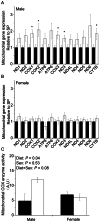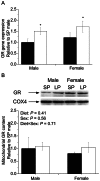Maternal low-protein diet affects epigenetic regulation of hepatic mitochondrial DNA transcription in a sex-specific manner in newborn piglets associated with GR binding to its promoter
- PMID: 23691106
- PMCID: PMC3653849
- DOI: 10.1371/journal.pone.0063855
Maternal low-protein diet affects epigenetic regulation of hepatic mitochondrial DNA transcription in a sex-specific manner in newborn piglets associated with GR binding to its promoter
Abstract
Mitochondrial oxidative phosphorylation (OXPHOS) plays an important role in energy homeostasis by controlling electron transfer and ATP generation. Maternal malnutrition during pregnancy affects mitochondrial (mt) DNA-encoded OXPHOS activity in offspring, yet it is unknown whether epigenetic mechanism is involved in the transcriptional regulation of mtDNA-encoded OXPHOS genes. In this study, 14 primiparous purebred Meishan sows were fed either standard- (SP, 12% crude protein) or low-protein (LP; 6% crude protein) diets throughout gestation, and the hepatic expression and transcriptional regulation of mtDNA-encoded OXPHOS genes were analyzed in newborn piglets. Maternal low protein diet decreased hepatic mtDNA copy number in males, but not in females. LP male piglets had significantly higher hepatic AMP concentration and low energy charge, which was accompanied by enhanced mRNA expression of NADH dehydrogenase subunits 6, cytochrome c oxidase subunit 1, 2, 3 and cytochrome b, as well as increased cytochrome c oxidase enzyme activity. In contrast, LP female piglets showed significantly lower hepatic AMP concentrations and higher energy charge with no alterations in OXPHOS gene expression. Moreover, LP males demonstrated higher glucocorticoid receptor (GR) binding to the mtDNA promoter compared with SP males, which was accompanied by lower cytosine methylation and hydroxymethylation on mtDNA promoter. Interestingly, opposite changes were seen in females, which showed diminished GR binding and enriched cytosine methylation and hydroxymethylation on mtDNA promoter. These results suggest that maternal low protein diet during pregnancy causes sex-dependent epigenetic alterations in mtDNA-encoded OXPHOS gene expression, possibly GR is involved in mtDNA transcription regulation.
Conflict of interest statement
Figures




Similar articles
-
Glucocorticoid receptor is involved in the breed-dependent transcriptional regulation of mtDNA- and nuclear-encoded mitochondria genes in the liver of newborn piglets.BMC Vet Res. 2013 Apr 26;9:87. doi: 10.1186/1746-6148-9-87. BMC Vet Res. 2013. PMID: 23618392 Free PMC article.
-
Maternal low-protein diet induces gender-dependent changes in epigenetic regulation of the glucose-6-phosphatase gene in newborn piglet liver.J Nutr. 2012 Sep;142(9):1659-65. doi: 10.3945/jn.112.160341. Epub 2012 Jul 25. J Nutr. 2012. PMID: 22833655
-
Low-protein diet fed to crossbred sows during pregnancy and lactation enhances myostatin gene expression through epigenetic regulation in skeletal muscle of weaning piglets.Eur J Nutr. 2016 Apr;55(3):1307-14. doi: 10.1007/s00394-015-0949-3. Epub 2015 Jun 12. Eur J Nutr. 2016. PMID: 26066356
-
Cytochrome c oxidase: evolution of control via nuclear subunit addition.Biochim Biophys Acta. 2012 Apr;1817(4):590-7. doi: 10.1016/j.bbabio.2011.07.007. Epub 2011 Jul 23. Biochim Biophys Acta. 2012. PMID: 21802404 Free PMC article. Review.
-
Epigenetic reprogramming of mtDNA and its etiology in mitochondrial diseases.J Physiol Biochem. 2024 Nov;80(4):727-741. doi: 10.1007/s13105-024-01032-z. Epub 2024 Jun 12. J Physiol Biochem. 2024. PMID: 38865050 Review.
Cited by
-
Integrating mitochondriomics in children's environmental health.J Appl Toxicol. 2015 Sep;35(9):976-91. doi: 10.1002/jat.3182. Epub 2015 Jun 5. J Appl Toxicol. 2015. PMID: 26046650 Free PMC article. Review.
-
Curcumin attenuates hepatic mitochondrial dysfunction through the maintenance of thiol pool, inhibition of mtDNA damage, and stimulation of the mitochondrial thioredoxin system in heat-stressed broilers.J Anim Sci. 2018 Apr 3;96(3):867-879. doi: 10.1093/jas/sky009. J Anim Sci. 2018. PMID: 29566233 Free PMC article.
-
Dietary Modulation of the Epigenome.Physiol Rev. 2018 Apr 1;98(2):667-695. doi: 10.1152/physrev.00010.2017. Physiol Rev. 2018. PMID: 29442595 Free PMC article. Review.
-
Perinatal Malnutrition Leads to Sexually Dimorphic Behavioral Responses with Associated Epigenetic Changes in the Mouse Brain.Sci Rep. 2017 Sep 11;7(1):11082. doi: 10.1038/s41598-017-10803-2. Sci Rep. 2017. PMID: 28894112 Free PMC article.
-
The distinct spatiotemporal distribution and effect of feed restriction on mtDNA copy number in broilers.Sci Rep. 2020 Feb 24;10(1):3240. doi: 10.1038/s41598-020-60123-1. Sci Rep. 2020. PMID: 32094402 Free PMC article.
References
-
- Yuzefovych LV, Solodushko VA, Wilson GL, Rachek LI (2012) Protection from palmitate-induced mitochondrial DNA damage prevents from mitochondrial oxidative stress, mitochondrial dysfunction, apoptosis, and impaired insulin signaling in rat L6 skeletal muscle cells. Endocrinology 153: 92–100. - PMC - PubMed
-
- Pajuelo D, Quesada H, Diaz S, Fernandez-Iglesias A, Arola-Arnal A, et al. (2012) Chronic dietary supplementation of proanthocyanidins corrects the mitochondrial dysfunction of brown adipose tissue caused by diet-induced obesity in Wistar rats. Br J Nutr 107: 170–178. - PubMed
-
- Choo HJ, Kim JH, Kwon OB, Lee CS, Mun JY, et al. (2006) Mitochondria are impaired in the adipocytes of type 2 diabetic mice. Diabetologia 49: 784–791. - PubMed
Publication types
MeSH terms
Substances
LinkOut - more resources
Full Text Sources
Other Literature Sources
Medical

